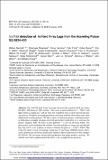NuSTAR detection of 4s Hard X-ray Lags from the Accreting Pulsar GS 0834-430
Author(s)
Bachetti, Matteo; Miyasaka, Hiromasa; Harrison, Fiona A.; Furst, Felix; Barret, Didier; Bellm, Eric C.; Boggs, Steven E.; Chakrabarty, Deepto; Chenevez, Jerome; Christensen, Finn E.; Craig, William W.; Grefenstette, Brian W.; Hailey, Charles J.; Madsen, Kristin K.; Natalucci, Lorenzo; Pottschmidt, Katja; Stern, Daniel; Tomsick, John A.; Walton, Dominic J.; Wilms, Jörn; Zhang, William; ... Show more Show less
DownloadBachetti-2014-NuSTAR detection of.pdf (816.7Kb)
PUBLISHER_CC
Publisher with Creative Commons License
Creative Commons Attribution
Terms of use
Metadata
Show full item recordAbstract
The NuSTAR hard X-ray telescope observed the transient Be/X-ray binary GS 0834–430 during its 2012 outburst. The source is detected between 3 – 79 keV with high statistical significance, and we were able to perform very accurate spectral and timing analysis. The phase-averaged spectrum is consistent with that observed in many other magnetized accreting pulsars. We fail to detect cyclotron resonance scattering features in either phase-averaged nor phase-resolved spectra that would allow us to constrain the pulsar’s magnetic field. We detect a pulse period of ~ 12:29 s in all energy bands. The pulse profile can be modeled with a double Gaussian and shows a strong and smooth hard lag of up to 0.3 cycles in phase, or about 4s between the pulse at ~ 3 and ≳ 30 keV. This is the first report of such a strong lag in high-mass X-ray binary (HMXB) pulsars. Previously reported lags have been significantly smaller in phase and restricted to low-energies (E<10 keV). We investigate the possible mechanisms that might produce such lags. We find the most likely explanation for this effect to be a complex beam geometry.
Date issued
2014-01Department
Massachusetts Institute of Technology. Department of Physics; MIT Kavli Institute for Astrophysics and Space ResearchJournal
EPJ Web of Conferences
Publisher
EDP Sciences
Citation
Bachetti, Matteo, Hiromasa Miyasaka, Fiona Harrison, Felix Fürst, Didier Barret, Eric C. Bellm, Steven E. Boggs, et al. “NuSTAR Detection of 4s Hard X-Ray Lags from the Accreting Pulsar GS 0834-430.” Edited by E. Bozzo, P. Kretschmar, M. Audard, M. Falanga, and C. Ferrigno. EPJ Web of Conferences 64 (2014): 06011.
Version: Final published version
ISSN
2100-014X